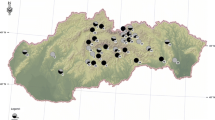Abstract
Dothistroma needle blight (DNB) is one of the most damaging foliage diseases of pine in plantations and natural forests worldwide and is caused by two closely related fungi: Dothistroma septosporum and D. pini, which are virtually impossible to differentiate from each other based on morphology. Although diagnosis of DNB based on symptoms is relatively reliable in the later stages of the disease when fruit bodies (conidiomata) are formed, for diagnosis in the early stages, as well as identification of the causal agent at species level, molecular methods are required. In addition, reliable and sensitive diagnostics before sporulation is a prerequisite for early detection to minimize accidental introductions of disease through movement of infected plant materials, especially seedlings. While amplification and sequencing of the ITS region of the rDNA alone is not reliable to differentiate the two species, conventional PCR (cPCR) using species-specific primers or mating type-specific primers and quantitative PCR (qPCR) are widely used and accepted molecular methods to identify and differentiate the DNB pathogens, either from cultures or directly from needles.
Access this chapter
Tax calculation will be finalised at checkout
Purchases are for personal use only
Similar content being viewed by others
References
Drenkhan R, Tomešová-Haataja V, Fraser S et al (2016) Global geographic distribution and host range of Dothistroma species: a comprehensive review. For Pathol 46:408¬442
Barnes I, Crous PW, Wingfield BD et al (2004) Multigene phylogenies reveal that red band needle blight of Pinus is caused by two distinct species of Dothistroma, D. septosporum and D. pini. Stud Mycol 50:551–565
Barnes I, Kirisits T, Wingfield MJ et al (2011) Needle blight of pine caused by two species of Dothistroma in Hungary. For Pathol 41(5):361–369
Groenewald M, Barnes I, Bradshaw RE et al (2007) Characterization and distribution of mating type genes in the Dothistroma needle blight pathogens. Phytopathology 97(7):825–834
Ioos R, Fabre B, Saurat C et al (2010) Development, comparison, and validation of real-time and conventional PCR tools for the detection of the fungal pathogens causing brown spot and red band needle blights of pine. Phytopathology 100(1):105–114
Schneider S, Jung E, Queloz V et al (2019) Detection of pine needle diseases caused by Dothistroma septosporum, Dothistroma pini and Lecanosticta acicola using different methodologies. For Pathol 49(2):e12495
Watt MS, Kriticos DJ, Alcaraz S et al (2009) The hosts and potential geographic range of Dothistroma needle blight. Forest Ecol Manag 257(6):1505–1519
Janosikova-Heckova Z, Ondruskova E, Barta M et al (2018) The hosts and geographic range of Dothistroma needle blight in Slovakia. For Pathol 48(3):e12421
Matsiakh I, Dogmus-Lehtijarvi HT, Kramarets V et al (2018) Dothistroma spp. in Western Ukraine and Georgia. For Pathol 48(2):e12409
Mullett MS, Adamson K, Bragança H et al (2018) New country and regional records of the pine needle blight pathogens Lecanosticta acicola, Dothistroma septosporum and Dothistroma pini. For Pathol 48(5):e12440
White TJ, Bruns T, Lee S et al (1990) Amplification and direct sequencing of fungal ribosomal RNA genes for phylogenetics. In: Innis MA, Gelfand DH, Sninsky J, White TJ (eds) PCR protocols: a guide to methods and applications. Academic Press, San Diego
Gardes M, Bruns TD (1993) ITS primers with enhanced specificity for basidiomycetes‐application to the identification of mycorrhizae and rusts. Mol Ecol 2(2):113–118
Korhonen K, Hintikka V (1980) Simple isolation and inoculation methods for fungal cultures. Karstenia 20(1):19–22
Fraser S, Weitz HJ, Brown AV et al (2016) Storage of Dothistroma septosporum cultures. For Pathol 46(5):547–550
Author information
Authors and Affiliations
Corresponding author
Editor information
Editors and Affiliations
Rights and permissions
Copyright information
© 2022 The Author(s), under exclusive license to Springer Science+Business Media, LLC, part of Springer Nature
About this protocol
Cite this protocol
Oskay, F., Lehtijärvi, A., Lehtijärvi, H.T.D. (2022). Detection and Identification of the Causal Agents of Dothistroma Needle Blight. In: Luchi, N. (eds) Plant Pathology. Methods in Molecular Biology, vol 2536. Humana, New York, NY. https://doi.org/10.1007/978-1-0716-2517-0_10
Download citation
DOI: https://doi.org/10.1007/978-1-0716-2517-0_10
Published:
Publisher Name: Humana, New York, NY
Print ISBN: 978-1-0716-2516-3
Online ISBN: 978-1-0716-2517-0
eBook Packages: Springer Protocols




